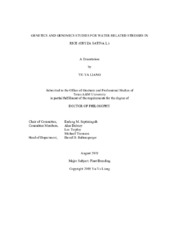| dc.description.abstract | Rice is one of the most important crops that feeds more than half of the world’s population. Along with the escalating problems with climate change, drought and submergence events have increased in recent years and have challenged the sustainability of rice production. This dissertation focused on these two water-related stresses, and studied the tolerance mechanisms underlying. Reproductive stage is the most water-sensitive period for rice cultivation, therefore the study was conducted to investigate the molecular and physiological responses of two rice genotypes, ‘Rondo’ and ‘4610’, to drought stress during reproductive stage under field conditions. Leaf samples were collected for RNA-Seq. Additionally, 10 agronomic traits and chlorophyll fluorescence were measured. The results showed that 4610 had better performance than Rondo under moderate drought stress conditions. The results indicated that 4610 had more stress responsive GO terms and several known genes families related to drought stress were also identified in 4610 up-regulated DEGs, including the LEA proteins, HSPs, APXs, and GSTs. The second goal was to characterize the region of qSub8.1, a new submergence tolerance QTL during vegetative stage, which will enable us to develop suitable DNA markers and identify the gene(s) underlying qSub8.1 for further functional characterization.
Three rice varieties, Ciherang-Sub1, Ciherang, and IR64-Sub1, were sequenced with 150 bp pair-end WGS. The results showed that Ciherang-Sub1 genome is composed of 59% Ciherang, 24% of IR64-Sub1, and 17% of unknown sources; and the qSub8 region is mainly from Ciherang with a few introgressed segments from IR64- Sub1 and unknown sources. There are challenges in conducting plant transformation and regeneration required to introduce the CRISPR reagents into the plant cell for gene-editing. Here, we used mature seeds as explants and reported a high-efficiency transformation and regeneration protocol for a recalcitrant indica rice cultivar Ciherang-Sub1 using particle bombardment to deliver CRISPR/Cas9 gene-editing vector. Our protocol successfully gives an optimal condition for shoot regeneration with 95% of regeneration rate and by using this protocol, CRISPR gene-edited plants can be generated and validated within approximately 12 weeks. Using this protocol, CRISPR gene-edited plants can be generated and validated within 12 weeks. | en |


